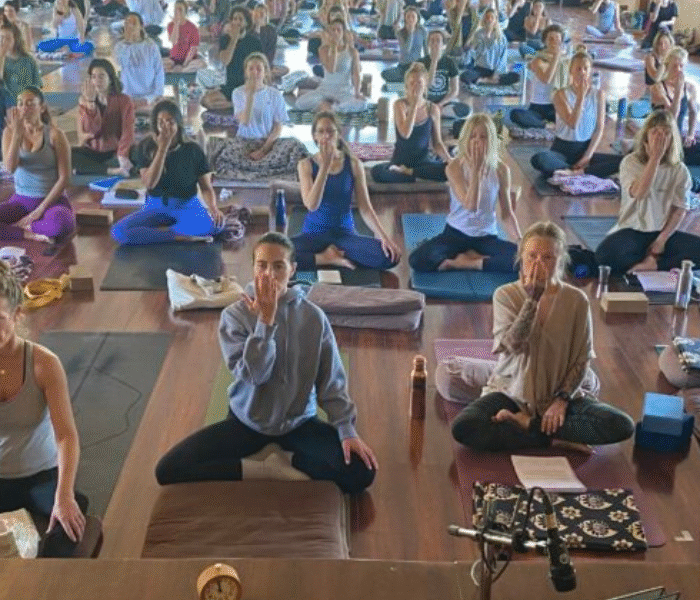10 tips to strengthen your yoga practice

After years of practicing yoga and learning from countless instructors, fellow yogis, and even personal experience, I’ve gathered these essential tips that have greatly helped me. Whether you’re a beginner or a seasoned practitioner, these practical insights can enhance your practice. Let’s dive in.
1. Aligning your neck for better posture
It’s common to feel neck strain, especially from modern habits like sitting at a desk or driving. When behind the wheel, we often push our chin forward, misaligning the neck and leading to discomfort. A simple exercise can help realign the neck:
Tip: Every time you stop at a red light, gently press your index finger against your chin and pull your head back. This small action helps release tension in the neck and ensures proper spinal alignment. Regularly practicing this can prevent long-term neck strain and improve posture over time.
2. How much water should you drink?
Hydration is key to a successful yoga practice, and you may be drinking less than you think. According to the American Heart Association, staying hydrated supports your joints, muscles, and overall performance.
Tip: Aim for at least 8 cups of water daily, and increase this to 12-16 cups if you’re engaging in hot yoga. Rather than drinking large amounts at once, sip water consistently throughout the day to prevent dehydration and keep your energy levels up.
3. Pain is not part of the process
One of the most misunderstood aspects of yoga is the role of pain. Many practitioners mistakenly push through discomfort, believing it will enhance their practice. However, yoga should never be about pushing to the point of pain.
Tip: If you feel any strain or discomfort in a pose, back off slightly, ease into the posture, and breathe deeply. This approach not only protects your body but also deepens your awareness and connection with your practice.
4. Mindful walking before and after class
Yoga isn’t just about what happens on the mat. Bringing mindfulness to other areas of life, like walking to and from class, can shift your perspective and help you integrate the practice more fully.
Tip: If possible, park a little farther from the studio and take a slow, mindful walk before and after class. Pay attention to your surroundings and notice how your body feels during the walk. This helps you transition into and out of your practice with a clearer mind.
Also read>>> Hanumanasana | Monkey pose
5. Hamstring tightness? Don’t forget the spine
Many students focus heavily on stretching their hamstrings, but it’s essential to also focus on the spine. A tight back can often contribute to discomfort in the legs.
Tip: When you feel tightness in the hamstrings, incorporate gentle spinal twists to release tension in your back. After a few twists, return to your hamstrings and notice if there’s a change in sensation, helping to deepen your stretch.
6. Meditation doesn’t have to be intimidating
Many people shy away from meditation because it seems overwhelming. However, meditation is a powerful tool for calming the mind and deepening your yoga practice. Start small and build gradually.
Tip: Begin with short, 5-minute meditation sessions in the morning. Find a quiet spot, sit comfortably, and simply focus on your breath. As you get more comfortable, gradually increase your time. Meditation doesn’t need to be intimidating; even brief sessions can have profound effects.
7. Invest in your own mat
Many yoga studios offer mats, but there’s something special about using your own. Your personal mat is clean, well-maintained, and customized to your needs.
Tip: If you’re practicing yoga regularly, investing in a quality mat is well worth it. It creates a sense of personal connection to your practice and provides a consistent foundation for your poses.
8. Savasana bliss: use an eye pillow
Savasana is often considered the most important part of the practice, as it allows the body to absorb the benefits of the poses. However, bright lights or distractions can prevent you from fully relaxing.
Tip: Try using an eye pillow during Savasana to block out light and deepen your relaxation. This simple addition helps calm the mind, relax the eyes, and enhance your meditation experience.
9. Embrace distractions
Yoga classes often bring us into close proximity with others, and sometimes their energy can be distracting. Instead of resisting, try using these distractions to learn more about yourself.
Tip: When someone’s presence or behavior distracts you, acknowledge how it makes you feel without judgment. Use this awareness to bring more focus to your practice. This approach will not only strengthen your poses but also cultivate mindfulness.
10. Balance tips for challenging poses
Some days, balancing poses like Tree Pose or Warrior III feel more difficult than others. A small adjustment in how you engage your feet can make a significant difference in your stability.
Tip: Try lifting the toes of your standing foot to activate all four corners of the foot. This helps distribute your weight evenly, improving balance and stability.
Whether you’re new to yoga or have been practicing for years, these tips are designed to improve both the physical and mental aspects of your practice. Drawing from personal experience, expert advice, and yoga tradition, I hope these suggestions will help you take your practice to the next level. Enjoy the journey!
Read next>>> Six sitting methods for practicing meditation




